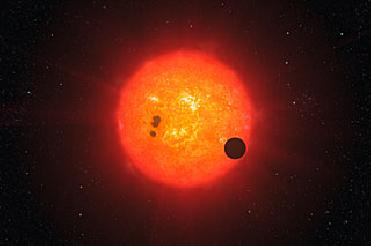
This artistís impression shows how the newly discovered super-Earth planet surrounding the nearby star GJ1214 may look. Image credit: ESO
PARIS (BNS): A super-Earth exoplanet surrounded by atmosphere has been spotted by astronomers just 40 light years away from our Earth.
The planet, GJ1214b, has a mass about six times that of Earth and it is revolving around a low-mass star, GJ1214. The star is five times smaller than our Sun and intrinsically three hundred times less bright, ESO said.
GJ1214b orbits its host star once every 38 hours at a distance of only two million kilometres – 70 times closer to its star than the Earth is to the Sun.
“Being so close to its host star, the planet must have a surface temperature of about 200 degrees Celsius, too hot for water to be liquid,” according to David Charbonneau, lead author of the paper reporting the discovery in the latest issue of Nature.
While the exoplanet’s interior is believed to be made of water ice, its surface appears to be fairly hot. The planet is surrounded by a thick atmosphere, rendering it inhospitable for life.
The new-found object falls in size between Earth and the ice giants of our Solar System, Uranus and Neptune.
This is the second time a transiting super-Earth has been detected, after the recent discovery of the planet Corot-7b which is the smallest and fastest-orbiting exoplanet known yet.
While GJ1214b’s mass is similar to that of Corot-7b, its radius is much larger. While Corot-7b probably has a rocky core and may be covered with lava, astronomers believe that three quarters of GJ1214b is composed of water ice, the rest being made of silicon and iron.
The most interesting feature of GJ1214b is its surrounding atmosphere which is about 200 km thick.
“This atmosphere is much thicker than that of the Earth, so the high pressure and absence of light would rule out life as we know it. But these conditions are still very interesting, as they could allow for some complex chemistry to take place,” Charbonneau said.
“Because the planet is too hot to have kept an atmosphere for long, GJ1214b represents the first opportunity to study a newly formed atmosphere enshrouding a world orbiting another star,” said team member Xavier Bonfils.
 Previous Article
Previous Article Next Article
Next Article













The Indian Air Force, in its flight trials evaluation report submitted before the Defence Ministry l..
view articleAn insight into the Medium Multi-Role Combat Aircraft competition...
view articleSky enthusiasts can now spot the International Space Station (ISS) commanded by Indian-American astr..
view article